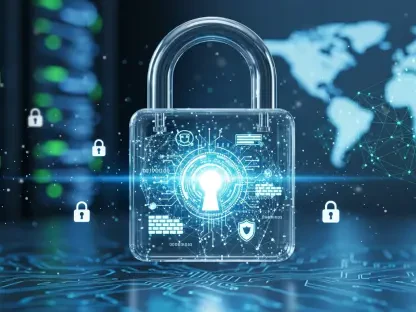In the tapestry of the digital age, data security has evolved from a mere necessity to an indispensable pillar of modern society. The rapid proliferation of technology and the exponential growth of interconnected systems have ushered in an era of unparalleled convenience and productivity.
Yet, this digital revolution has also cast a long shadow, giving rise to a complex web of data vulnerabilities that demand our utmost attention and vigilance. In fact, more than 493 million cyber threats were detected worldwide by organizations, underscoring the importance of a robust security protocol. That said, let’s delve into the intricacies of fortifying data security and take a hard look at the layers that surround the safeguarding of sensitive information in the face of emerging threats and challenges.
The Paradigm of Data Vulnerability
In an era where data is considered the new currency, the paradigm of susceptibility has taken on unprecedented significance. The very fabric of cyberspace, once seen as an empire of limitless possibilities, is now a battlefield where information is both a prized asset and a potential liability. As technological advancements continue to redefine the boundaries of innovation, the risks that accompany these advancements also expand exponentially.
The Reality of Digital Threats
The landscape of weaknesses is further complicated by the diverse array of threat actors that lurk in the shadows of cyberspace. From state-sponsored entities with sophisticated resources at their disposal to hacktivists driven by ideological motivations, the spectrum of adversaries is as diverse as it is formidable. The emergence of organized crime groups leveraging digital tools for financial gain has further intensified the battleground.
The Criticality of Sensitive Information
Amid the evolving landscape of vulnerabilities, the criticality of sensitive information becomes evident. Delicate information encompasses a wide spectrum of data, ranging from personally identifiable information (PII) to intellectual property (IP). PII, often comprising an individual’s name, address, social security number, and financial records, serves as a digital fingerprint that can unlock doors to identity theft and financial fraud. IP, on the other hand, represents the lifeblood of organizations and industries, including trade secrets, proprietary algorithms, and strategic plans. The preservation of delicate information transcends mere security protocols — it becomes a moral imperative to protect the trust placed in institutions by individuals.
The Anatomy of Data Breaches
The analysis of security breaches serves as a sobering reminder of the dynamic interplay between technological advancements and the vulnerabilities they introduce. Data breaches, ranging from high-profile incidents to subtle infiltrations, encompass a multitude of patterns and tactics.
Malware Intrusions
Malicious intrusions stand as a prevalent and versatile modus operandi adopted by cyberattackers to breach systems and gain unauthorized access. This multifaceted threat encompasses a variety of malicious software designed to infiltrate vulnerabilities and compromise digital assets.
- Vulnerability exploitation: Cybercriminals leverage software vulnerabilities to introduce malware into systems. Outdated software, unpatched applications, and weak security configurations become the entry points for these attacks.
- Types of malware: Viruses come in various forms, such as worms, Trojans, and spyware. Each variant carries its own payload and functionality, making detection and mitigation an intricate task.
- Propagation and lateral movement: Once inside a network, viruses often seek to spread laterally, infecting interconnected devices. This lateral movement aids cybercriminals in achieving their objectives stealthily.
Ransomware Attacks
In the realm of cyber threats, ransomware attacks have emerged as a menacing force that holds organizations hostage by encrypting vital data and demanding ransom payments in exchange for decryption keys.
- Encryption as a weapon: Ransomware encrypts data, rendering it inaccessible to authorized users. The attackers dangle the decryption key as a bargaining chip, demanding ransom payments to release the seized data.
- Financial and operational impact: Beyond the immediate ransom demand, organizations must also contend with the ripple effects of downtime, data loss, and reputational damage. The financial toll of ransoms and recovery efforts can be substantial.
- Evolution of ransomware: Ransomware attacks have evolved from opportunistic assaults to targeted campaigns. Threat actors meticulously select high-value targets and craft tailored attacks, amplifying the potential impact.
Insider Threats
While data security often focuses on external threats, the duality of insider threats introduces an intricate layer of complexity. Authorized individuals, driven by malicious intent or negligence, wield their access as a weapon.
- Malicious insiders: Employees, contractors, or partners with authorized access may exploit their privileges to steal sensitive data, sabotage systems, or cause harm. Motives can range from financial gain to vendettas against the organization.
- Negligent actions: Not all insider threats are malicious; negligence can also expose sensitive information. Unintentional sharing of credentials, mishandling of data, or falling for social engineering ploys can inadvertently compromise security.
- Challenges in detection: Insider threats pose unique challenges in detection due to the authorized nature of their activities. Organizations need to strike a balance between security measures and fostering a trusting work environment.
The consequences of data breaches extend far beyond the initial breach itself. Financial loss resulting from ransom payments, regulatory penalties, and legal settlements can cripple organizations. The breach of sensitive information, such as healthcare records or financial data, can also have significant societal implications, endangering individuals’ well-being and privacy. Thus, organizations are confronted with a moral and ethical imperative to fortify their defenses against an ever-evolving array of threats.
The Resilience of Encryption
Encryption stands as a bastion of resilience against the ceaseless onslaught of threats. A centuries-old practice, encryption transforms data into a form that is unreadable to unauthorized individuals. This transformation, achieved through intricate algorithms and cryptographic keys, ensures that only those with the appropriate decryption keys can access the information. The diversity of encryption methods, ranging from symmetric to asymmetric cryptography, provides a spectrum of tools to secure data both in transit and at rest.
Encryption Protocols
The resilience of encryption becomes particularly evident in its application to secure data transmission over networks. Secure Sockets Layer (SSL) and its successor, Transport Layer Security (TLS), establish encrypted communication channels between users and web servers. These protocols ensure that sensitive information exchanged between parties remains confidential, safeguarding against eavesdropping and unauthorized interception.
Yet, encryption is not a panacea; it is a tool in a much larger arsenal of security measures. Key management, the intricate process of generating, distributing, and storing cryptographic keys, is an often overlooked but crucial aspect of encryption. The compromise of encryption keys can render even the most robust encryption useless, emphasizing the importance of robust key management practices.
Emerging Frontiers: AI and Data Security
Artificial Intelligence (AI), frequently lauded for its transformative potential, has also emerged as a double-edged sword in the realm of data security. AI’s ability to process vast amounts of data and recognize patterns makes it a valuable ally in the fight against cyber threats.
AI’s Role in Proactive Threat Detection
Machine learning models, driven by AI, can identify anomalies and deviations from expected behavior, providing organizations with proactive threat detection capabilities. Additionally, behavioral biometrics, a subset of AI, leverages individual behavioral patterns such as keystroke dynamics and mouse movement to authenticate users. This multifaceted approach to authentication enhances security by adding an extra layer of verification.
Adversarial AI: A Cybersecurity Arms Race
The rise of adversarial AI highlights the arms race between attackers and defenders, involving the use of AI-powered attacks to exploit vulnerabilities and breach defenses. Adversaries can manipulate machine learning models by providing subtle inputs that lead to incorrect predictions or misclassifications. This phenomenon underscores the need for machine-powered defense mechanisms that can counteract these attacks.
The Human Factor: Cultivating a Culture of Security
While technology serves as the backbone of data security, the human factor remains a pivotal component of the security ecosystem. The intersection of human behavior and technology introduces both opportunities and challenges. Cultivating a culture of security within organizations and society at large is a proactive approach to minimizing human-driven vulnerabilities.
Cyber Awareness Training
One of the fundamental aspects of cultivating a culture of security is cyber awareness training. This training equips individuals with the knowledge and skills to recognize and respond to common cyber threats, such as phishing attempts and social engineering tactics. Recognizing the intricacies of social engineering, which often exploits human psychology, empowers individuals to be vigilant against manipulation.
Enhanced Security Through Multi-Factor Authentication
Multi factor authentication (MFA), a security mechanism that requires users to provide multiple forms of identification before accessing systems or data, adds an extra layer of security. MFA mitigates the risk of unauthorized access, even if credentials are compromised. Biometric authentication, such as fingerprint or facial recognition, leverages unique physical attributes to enhance user verification.
Leading by Example
Organizational leaders play a pivotal role in driving a culture of security. Leading by example, promoting open communication, and establishing clear policies create an environment where individuals feel empowered to report potential safety incidents. Moreover, a culture that recognizes and rewards security-conscious behavior fosters a sense of ownership and responsibility among employees.
The Future: Pioneering Data Security Innovations
As we peer into the horizon of data security, it becomes evident that innovation will shape the trajectory of defense mechanisms. Quantum computing, with its unparalleled processing power, introduces both opportunities and challenges. Post-quantum cryptography, a field that spans research and implementation, seeks to develop encryption methods that can withstand quantum-powered attacks. The field is characterized by diverse cryptographic algorithms, each vying to emerge as the standard for a quantum-resilient future.
Quantum Key Distribution (QKD)
QKD, a subset of quantum cryptography, leverages the principles of quantum mechanics to establish secure communication channels. Unlike classical encryption, which relies on mathematical algorithms, QKD is based on the principles of quantum entanglement and uncertainty. This cryptographic mechanism offers a level of security that is theoretically unbreakable, ushering in an era of ultra-secure data transmission.
Blockchain’s Potential for Data Security
The rise of blockchain technology, often associated with cryptocurrencies, also has profound implications for data security. Blockchains are distributed and tamper-evident ledgers that record transactions in a transparent and immutable manner. The decentralized nature of blockchain ensures that no single entity has control over the data, mitigating the risks of centralized data breaches. Blockchain technology can also enable self-sovereign identity, where individuals have control over their personal information and choose when and how to share it.
Final Thoughts
As we navigate the complex labyrinth of data security, one thing becomes clear: safeguarding sensitive information is an ever-evolving endeavor. The symphony of technology, human behavior, regulations, and innovation creates a dynamic ecosystem where adaptation is the key to survival. Organizations and individuals must embark on a continuous journey of learning, collaboration, and adaptation.
In this pursuit, knowledge becomes the armor against emerging threats, and collaboration becomes the foundation of a united defense. The symphony of technology, human behavior, regulations, and innovation will ultimately create a dynamic ecosystem where adaptation is the key to survival.









